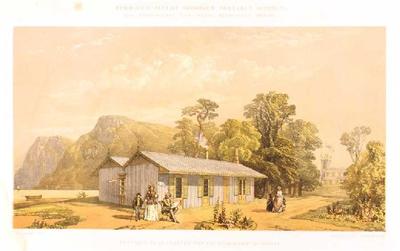Lithograph
Maker & role
Day & Son Ltd (estab. 1823, closed 1866), Publisher; William Simpson (b.1823, d.1899); R.I., Lithographer; Samuel Hemming (b.1799, d.1876), Producer
Production date
1853-1854
See full details
Object detail
Title
(Portable house) Proposed to be erected for the Archbishop of Sydney
Production place
Measurements
H: 28.4 x W: 38.7cm (H: 284 x W: 387mm)
Credit line
Gift, through the Australian Government’s Cultural Gifts Program, 2004
Caroline Simpson Collection, Caroline Simpson Library & Research Collection, Museums of History New South Wales
Caroline Simpson Collection, Caroline Simpson Library & Research Collection, Museums of History New South Wales
Caption
Proposed to be erected for the Archbishop of Sydney, by William Simpson (lithographer), 1853-54, lithograph
Description
One of a collection of five coloured lithographs illustrating portable iron buildings, produced by Samuel Hemming of Bristol, intended for the Australian colonies. The lithographs were produced in the period 1853-54 by Day & Son, London and each image is 20cm x 35cm.
The lithographs are entitled:
i) A Portable Town for Australia…showing the Church and Parsonage House as ordered to be sent out to the Bishop of Melbourne
ii) Parsonage House for the Diocese of Melbourne
iii) [House] Proposed to be erected for the Archbishop of Sydney
iv) View of an Emigrant’s House to Accommodate 72 Persons…on the Plan suggested by Mrs Chisholm
v) Villa residence
Each of these is a perspective view, showing the building or buildings set in a semi-tropical landscape, not specifically Australian, and each bears the heading “Hemming’s Patent Improved Portable Houses”.
These lithographs are indicative of the type of prefabricated buildings imported into New South Wales and Victoria during the early 1850s. Very few of these buildings survive. The use of prefabricated buildings in Australia has a long history. However it was the second half of the 19th century that saw the greatest importation of this type of building into New South Wales, particularly during the gold rushes. Several British firms supplied the Australian market during this period however Samuel Hemming of Clift House, Bristol was pre-eminent amongst these. His firm was one of the earliest suppliers of iron prefabricated houses and the firm certainly provided the greatest range of building types – houses (ranging from cottages and parsonages to villas), schools, shops, hotels, churches and a migrant’s hostel. Hemming promoted his buildings through the publication of coloured lithographs such as these images and their distribution appears to have been widespread. Today, however, few other collections similar to this group of images are known to exist (two in Australia and two in Great Britain).
Samuel Hemming was said to have established his portable house manufactory after successfully constructing a light portable house for a son who was emigrating to Australia. He exhibited his buildings at the Dublin Great Industrial Exhibition of 1853 and was by that time established as one of the pre-eminent British manufacturers of portable buildings. In the pattern book of Hemming's portable houses held in the Baillieu Library, University of Melbourne, this building is shown to have four bedrooms, a drawing room, a dining room, and two small closets. It is listed as design no.20, costing 420 guineas, and twelve of them were to be built for the Bishop of Sydney.
This acquisition is part of the Caroline Simpson Collection, originally housed at Clyde Bank, an 1820s Georgian mansion in The Rocks. Clyde Bank was acquired by Caroline Simpson in 1992 and, following its conservation, opened to the public in 1996 as a showcase for her private collection of Australian colonial furniture, pictures, objets d’art and images of colonial places from around the world. Caroline Simpson OAM (1930-2003) supported many causes during her lifetime, particularly the conservation and appreciation of Australia’s colonial heritage. Her philanthropy was generous but mostly anonymous.
The lithographs are entitled:
i) A Portable Town for Australia…showing the Church and Parsonage House as ordered to be sent out to the Bishop of Melbourne
ii) Parsonage House for the Diocese of Melbourne
iii) [House] Proposed to be erected for the Archbishop of Sydney
iv) View of an Emigrant’s House to Accommodate 72 Persons…on the Plan suggested by Mrs Chisholm
v) Villa residence
Each of these is a perspective view, showing the building or buildings set in a semi-tropical landscape, not specifically Australian, and each bears the heading “Hemming’s Patent Improved Portable Houses”.
These lithographs are indicative of the type of prefabricated buildings imported into New South Wales and Victoria during the early 1850s. Very few of these buildings survive. The use of prefabricated buildings in Australia has a long history. However it was the second half of the 19th century that saw the greatest importation of this type of building into New South Wales, particularly during the gold rushes. Several British firms supplied the Australian market during this period however Samuel Hemming of Clift House, Bristol was pre-eminent amongst these. His firm was one of the earliest suppliers of iron prefabricated houses and the firm certainly provided the greatest range of building types – houses (ranging from cottages and parsonages to villas), schools, shops, hotels, churches and a migrant’s hostel. Hemming promoted his buildings through the publication of coloured lithographs such as these images and their distribution appears to have been widespread. Today, however, few other collections similar to this group of images are known to exist (two in Australia and two in Great Britain).
Samuel Hemming was said to have established his portable house manufactory after successfully constructing a light portable house for a son who was emigrating to Australia. He exhibited his buildings at the Dublin Great Industrial Exhibition of 1853 and was by that time established as one of the pre-eminent British manufacturers of portable buildings. In the pattern book of Hemming's portable houses held in the Baillieu Library, University of Melbourne, this building is shown to have four bedrooms, a drawing room, a dining room, and two small closets. It is listed as design no.20, costing 420 guineas, and twelve of them were to be built for the Bishop of Sydney.
This acquisition is part of the Caroline Simpson Collection, originally housed at Clyde Bank, an 1820s Georgian mansion in The Rocks. Clyde Bank was acquired by Caroline Simpson in 1992 and, following its conservation, opened to the public in 1996 as a showcase for her private collection of Australian colonial furniture, pictures, objets d’art and images of colonial places from around the world. Caroline Simpson OAM (1930-2003) supported many causes during her lifetime, particularly the conservation and appreciation of Australia’s colonial heritage. Her philanthropy was generous but mostly anonymous.
Accession number
L2005/8-3



Public comments
Be the first to comment on this object record.